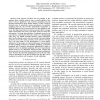Free Online Productivity Tools
i2Speak
i2Symbol
i2OCR
iTex2Img
iWeb2Print
iWeb2Shot
i2Type
iPdf2Split
iPdf2Merge
i2Bopomofo
i2Arabic
i2Style
i2Image
i2PDF
iLatex2Rtf
Sci2ools
P2P
2007
IEEE
2007
IEEE
Grid Resource Scheduling with Gossiping Protocols
Abstract— Grid resource providers can use gossiping to disseminate their available resource state to remote regions of the grid to attract application load. Pairwise gossiping protocols exchange information about limited subsets of other resources between pairs of potentially remote participants. In epidemic gossiping protocols, the provider disseminates information to multiple neighbors, who in turn forward it to their neighbors, and so on. One important metric for these protocols is their coverage, which characterizes how many and which resources receive the information. Coverage characteristics of epidemic protocols are non-uniform, concentrated within the vicinity of a disseminating node; they can exhibit bi-modal behavior where information either reaches distant nodes or dies out quickly. Pairwise gossiping protocols, on the other hand, provide a more uniform coverage, but it can take longer for the dissemination to reach desired uniformity. In this paper, we study performance c...
Epidemic Gossiping | Epidemic Gossiping Protocols | P2P 2007 | Pairwise Gossiping Protocols | Peer-to-Peer Computing |
| Added | 04 Jun 2010 |
| Updated | 04 Jun 2010 |
| Type | Conference |
| Year | 2007 |
| Where | P2P |
| Authors | Deger Cenk Erdil, Michael J. Lewis |
Comments (0)

